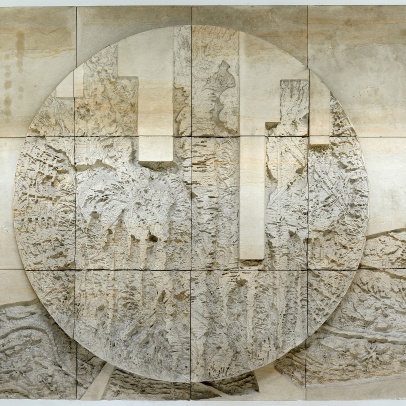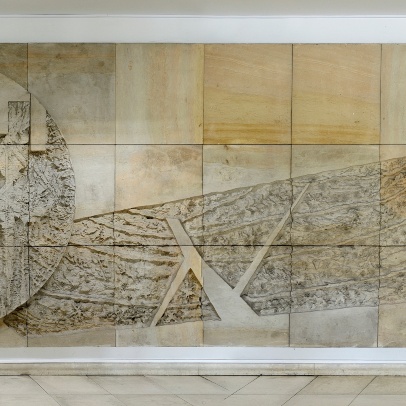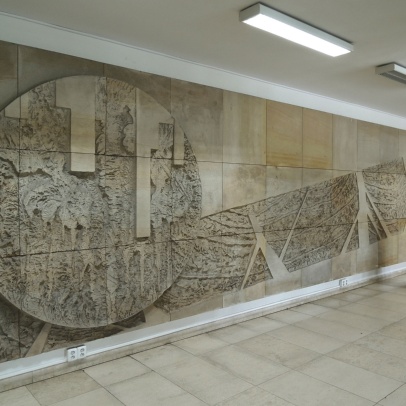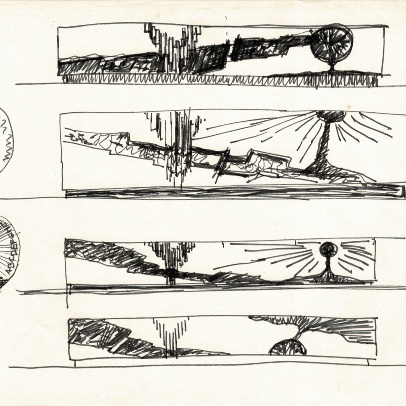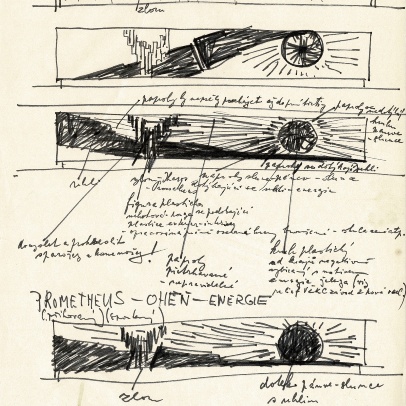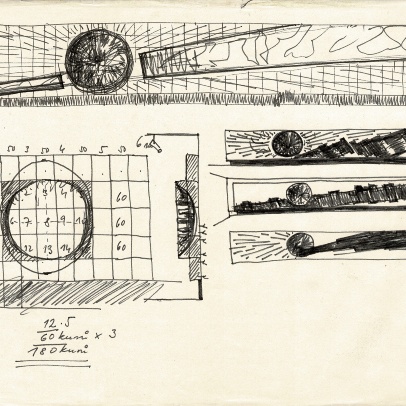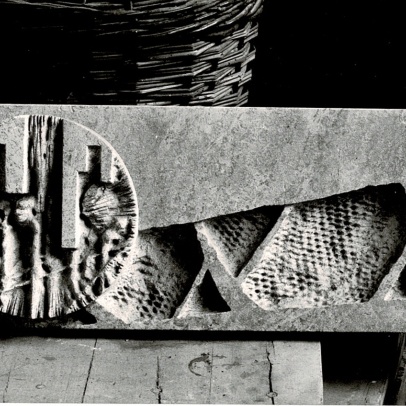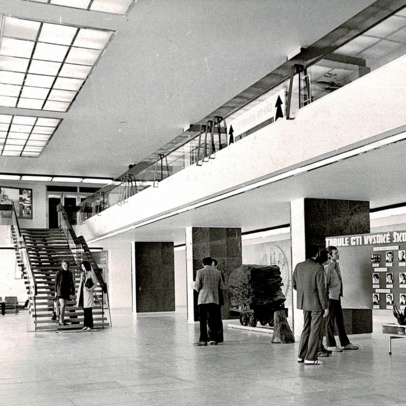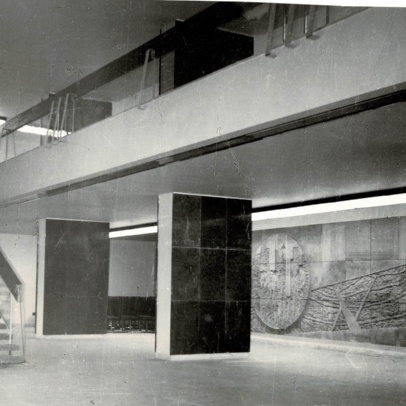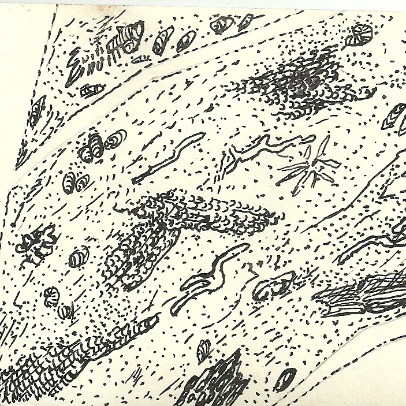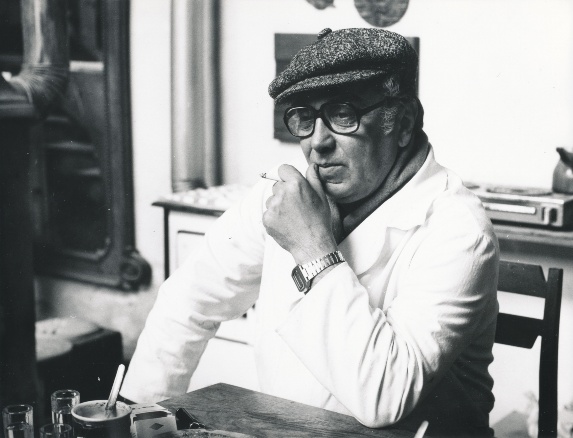Name: Coal and Iron / The Birth of Coal
Author: Vladislav Gajda
Dating: 1968–1972
Location: the VŠB-TUO Rectorate and Faculties lobby
Execution: sandstone relief, 240 x 1400 cm
GEOLOGICAL SECTION OF THE CZECHOSLOVAK PART OF THE UPPER SILESIAN BASIN IN AN ARTISTIC CONCEPT
The sandstone relief Coal and Iron / The Birth of Coal is part of a monumental installation of three of Gajda’s works of art, which complement the architecture of the main entrance to the VŠB-TUO Rectorate building (for more details see Prometheus/Expansion of Science, Technology and Civilization).
The large sandstone relief reflects the idea of the bronze Prometheus wings above the entrance to the building. More specifically, however, it is related to the “birth of coal”, which were poetically portrayed for the then building of the headquarters of the Northern Railway by Gajda’s teacher Jan Lauda at the turn of the 1930s and 1940s.
In the 1960s and 1970s, Vladislav Gajda created an array of sculptural projects for the public space that benefited both from the natural physical and optical properties of the stone. He himself preferred work by the so-called taille-directe method, in other words, method of direct contact with the material – stone, including the hardest granite and diorite; it was the material he liked working with best. The structure of the block often coincided with the intended shape, the penetration into its core and the method of surface finishing. On large surfaces, he often used the technique of processing sandstone into relief by blasting. Coal and Iron also belong to this category.
A stylized image of the Earth’s core, in which magma rises up from the smooth background of the sandstone slabs; this part can be perceived as an allusion to the process of ore mining and processing. The disk intersects with the diagonal of the underground, in which coal layers are formed from prehistoric vegetation. In both formations, stylized smooth surfaces contrast with unstable, nervously disturbed or coarsely wrinkled structures. The morphology of the relief wall is guided by the idea of stability and transformation it has gone through during millions of years of the Earth’s existence and the “short” centuries of human activity.
Gajda had created a number of study sketches for the relief’s detail ranging from realistic illustrations of prehistoric plants and animals to their imaginary blending in an abstract vortex depicting “rock-forming processes”. The three-page manuscript, where the sculptor describes the depicted processes in detail, surprisingly at a high professional level, has been preserved. In two sentences in the corner of one of the sheets, the author expressed, in a nutshell, the contents of both parts of his artwork: “The basin symbolizes the unity of all the natural forces. Fire, the bearer of energy and life, is brought by Prometheus.”
The author intended to depict the “geological section of the Czechoslovak part of the Upper Silesian Basin” in an artistic way. “Thickness of individual layers and tectonic elements were generalized in order for the entire profile to be readable on such a large area. The profile thus captures one of the best-known deep geological sections measured by the years of intense mining activity and extensive geological survey over the past years. Still, using this relief, I do not only intend to show a realistically (or even naturalistically) captured geological section, depicting underlying layers of non-productive carbon in the west, the coal-bearing Ostrava field and Karviná strata series of the upper carbon with the late Tertiary overlay. It is about capturing one of the evolutionary stages of the Earth’s crust in a certain space, time and their dialectical context.”
It is obvious that before the creation of the final design and its conversion into stone, the sculptor thoroughly familiarized himself not only with geological processes but also with elements of organic life. These elements are displayed using different scales. Fossils can be viewed in real size, while “microscopic residues of plant tissues, pollen and spores forming coal mass are multiplied”. In short, the relief depicts the development of the Earth’s crust, as well as the formation of mineral resources that are used in the industry.
As already mentioned, Vladislav Gajda’s favourite technique of working with monumental sandstone relief walls was sandblasting, which he used to carry out in the former chateau park in Ostrava-Třebovice, where he had his studio. This group of Gajda’s works also includes Coal and Iron. All the above-described motifs of petrified plants and animals have been created in sandstone slabs in this way.
